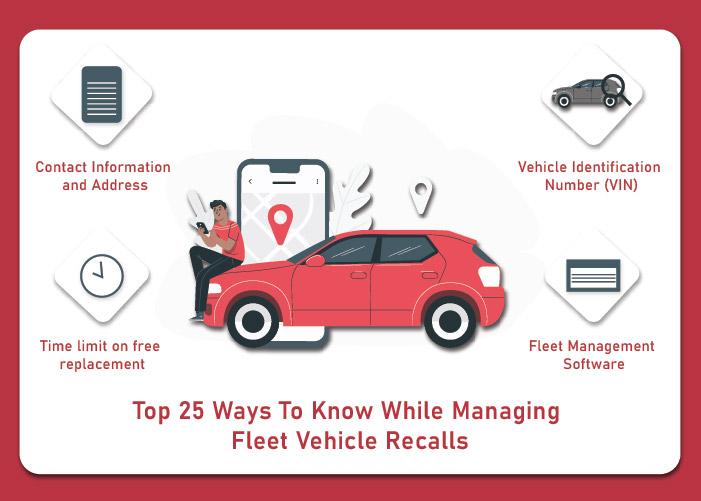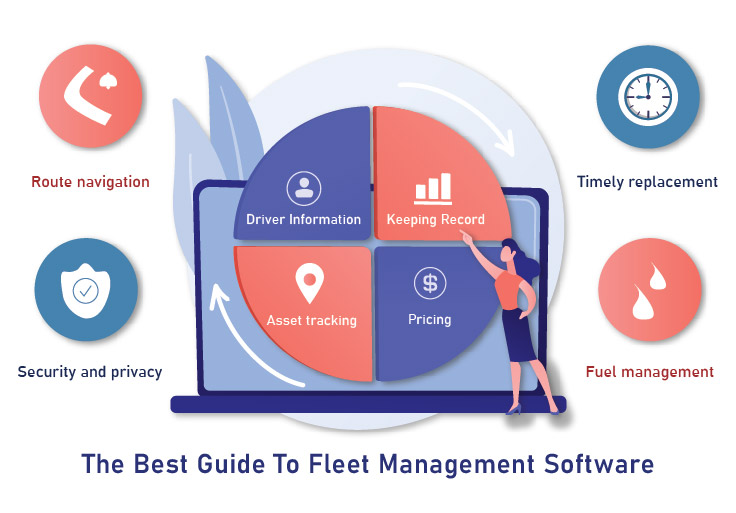If you are a fleet owner, you probably fear this term and its damaging consequences in your line of work.
A vehicle recall can potentially bring your fleet to a temporary standstill, and cost you a heavy chunk of business, not to mention the logistical and administrative issues that it might drag in.
Since its record year in 2014, there has been an ever-increasing rate of recalls in the US alone.
Thus, recall management is becoming a pressing matter that calls for an immediate change in procedures on the supply and manufacturing end.
However, there are ways to manage your fleet so that in case of a recall, your business would emerge almost unscathed while ensuring the complete safety of your vehicles and employees.
This article will provide you with direction for everything from detecting a recall to useful tools for managing your recall phase.
1. Vehicle Identification Number (VIN)
If you are a new fleet owner, you might want to begin from the basics.
A Vehicle Identification Number or VIN is a 17-digit code that is generally located between the dashboard and windshield, on the driver’s side doorjamb.
It is essential for every fleet to have a directory of all VINs in the fleet in order to keep track of their status on the recall lists.
2. Contact Information and Address
In case of a recall, manufacturers are required by law, to send to your address a hard copy of the recall notice.
If you have recently moved offices or made any changes to your mailing address, it is imperative for you to update your address in your manufacturer’s directory.
It is good practice to update it monthly to avoid delays in your receipt of the notice.
3. The notice
Upon receipt of the notice, these are the things you should look out for:
a) A description of the defects.
b) The potential risk, injury, or safety hazard that is a consequence of this defect.
c) Warning symptoms or signs of a problem.
d) A solution or plan to fix the problem from the manufacturer’s end.
e) Details of the availability and duration of the repair.
f) What are the next steps
4. Routine Checks
Despite the requirement for a hard copy of the notice, waiting for the letter might delay your recall significantly.
Make it a habit to routinely check recall lists for your VINs.
Websites like recalls.gov and carfax.com, are good places to make a beginning.
5. Inquiry Methods
Registering accounts with DealerCONNECT and FCA US LLC Fleet Operations will help you track open recalls and Rapid Response Transmittals (RRT).
6. Inquiry tool
fcausfleet.com is a tool designed for fleets, with the following benefits:
-Provides RRT no., date, location and description
-Invalid VIN report, and summary report
-It is a multi-VIN lookup tool and has user a friendly format
7. Recall list trackers
As a fleet manager, there might be times when you forget to check the aforementioned lists, and it is necessary for you to prioritize your tasks.
Therefore, automating the process using recall list trackers might be a good idea.
Some examples of tracking services are Donlen and AutoAP.
8. Fleet Management Software
Good Fleet Management Software generally comes with the recall list-tracking feature, and having all your fleet management in one place is convenient for the smooth operation of your day-to-day business.
9. Wait for reliable Notifications
In many cases, VIN databases are not updated before the recall announcement is in the news.
In some cases, only specific parts of certain models are to be re-assessed, and waiting for your VINs to show up on a list will save you the unnecessary hassle of getting parts changed that didn’t require changing in the first place.
10. Time limit on free replacement
According to the NHTSA, the time frame within which a vehicle is eligible for repair, free of charge, is 10 years from the original sale date.
However, there is a different condition on tires.
The limit within which you are required to replace your tires is 60 days.
11. Early Appointments
It is best to make a servicing appointment with your dealer as soon as the recall is confirmed.
In most cases, large-scale recalls have unbelievably long queues, and it could cost you a lot of time to delay the process in any capacity.
12. Prioritize dealerships by time
It is entirely plausible that the dealership closest to you might not be your best fit since it has more customers.
Calling all dealerships at a reasonable distance could get you to the front of a long queue.
13. Prioritize dealerships by the availability of parts
Call dealers beforehand to know if they have an adequate supply of parts.
This could save you the risk of waiting for a long time, only for your dealer to run out of parts when it’s your turn.
14. Schedule parts procurement
In case you are stuck without parts, contact FCA’s fleet customer hotline to schedule the procurement of parts or services or access its online database (www.mopar.com/en-us/my-vehicle/recalls.html)
15. Fleet dealerships
Working with a dealership with a dedicated fleet service counter would be a better alternative to a general dealer since it would be more equipped to deal with your fleet.
16. Develop a system
Having a working rapport with your dealer and forming a system for repairs will go a long way in stabilizing your recall phase.
17. Loaner Vehicles
Since it is unsafe for recalled vehicles to be used before repairs, though they aren’t legally required to do so, some manufacturers provide fleets with loaner vehicles for a given amount of time.
Always check for this option while giving your vehicles for repair.
18. Renting Vehicles
If your manufacturer refuses to provide a loaner vehicle, and your business cannot survive the brief standstill, hiring other fleets to temporarily work under you, are a good idea.
These costs could be recovered in the long run, once your vehicles are back on track.
19. Rotate back-to-back
Rotating your vehicles with your dealer one at a time could make the process almost seamless as it gives you maximum control over the process.
It would help your business avoid the complete system shut down that would come with sending in all your vehicles at once. However, make sure not to put on the road vehicles that have significant or life-threatening issues.
20. Prioritize defects
When sending your vehicles in, prioritizing serious defects like airbag or tire issues over defects like replacing a trunk lock, will help you get back into the business faster.
However, it is necessary to inspect the defect carefully since seemingly small defects such as changing a tire pressure sticker could have harsh consequences in the long run. (Look at point 21 and 22 for examples of safety and non-safety related defects)
21. Safety-related defects
Here is a brief list of some safety-related defects to watch out for and prioritize over other defects, as mentioned by the NHTSA:
– Loss of vehicle control due to steering parts and components breaking suddenly and without the warning.
– Break in accelerator controls.
– Risk of vehicle fires due to problems with fuel system components.
These could cause leakage in the case of crash damage.
– Accelerator controls being stuck
– Cracking or breaking wheels that cause a loss in vehicle control.
– Breaking or falling apart of critical vehicle components that could cause injury to persons inside or outside the vehicle or cause loss of vehicle control
– Cooling fan blades for engines that break unexpectedly, injuring persons working on a vehicle.
– Non-operational or inefficient windshield wiper assemblies.
– Unexpected break or movement in seats or seat backs.
– Unexpected airbag deployments in situations where they aren’t supposed to deploy.
– Problems in headlights caused by vehicle wiring systems that could cause a lack of lighting while driving in the dark.
– Problems or issues with child safety seats, their components, buckles, or other parts that may result in injury during operational or non-operational use of the vehicle.
– Collapsing or unstable car jacks or ramps that could cause serious injury to persons working on the car.
In case your vehicles contain any of the above defects, it is imperative for you to repair them at the earliest.
22. Non-safety related defects
Here are some defects that are not directly safety related and can be given second-priority during a recall:
– Body panel or nonstructural rust.
– Non-operational Air Conditioners or Radios.
– The wear and tear of equipment such as shock absorbers, batteries, brake pads and shoes, and exhaust systems.
– Excessive or unusual oil consumption.
– Blemishes that are cosmetic or are due to bad quality paint.
Though these defects are not directly safety-related, they can lead to situations of discomfort for your employees and must not be ignored as unimportant.
23. Don’t hesitate with recalls
There is a common misconception that dealers don’t give priority to recall work since it is a free service.
This isn’t true because recalls are an opportunity for dealerships to gather new customers and increase their range of business. In most cases, they will try to maintain a good reputation with regard to free services.
24. Avoid unnecessary services
Beware of getting upsold into services that are costly and unnecessary.
Though these services might appear relevant, if they are not safety-related, your only goal for the recall should be to go through the process as scheduled.
25. Replacement vehicles
Keep one replacement vehicle in every class to minimize downtime during the recall or repair phases.
It would also be advisable to maintain a good rapport with vehicle rentals or rental fleets so they could help you out of the recall phase at a reasonable price.
Things to remember at the time of forming your fleet

1. Diversify
While it is necessary to form a uniform fleet with maximum productivity, no one car or bike is perfect. Diversifying vehicle models will reduce the risk of losing your entire fleet to a recall.
2. Choose your brand carefully
Research your chosen brand to ascertain whether it has had a history of bad products and recalls, and whether it has a smooth system in place for rectifying the defects.
3. Check VINs
Before buying any vehicle, run it’s VIN by the recall lists that are available online to avoid the bad investments.
It is legal for dealerships to sell cars with open recalls under the term “used cars”.
It is in your best interest to check your VIN even if you are buying second-hand from the individuals instead of dealers.
While buying a car under recall is not necessarily bad, it might get you a better price on the vehicle if you know the extent or the status of the recall.
4. Report Safety Issues
Always report safety defects in your vehicles to the NHTSA, just in case your model is eligible for a recall.
It would contribute to safer roads and also negate your replacement expenses.
Ethics with regard to recalls

Every fleet owner is aware of the potential damage that a large-scale recall can do to their business.
However, ignoring a recall or not having a system in place to detect a recall could be damaging not only to your business but also to the lives of your employees.
It is essential to build a system to detect and track recalls not only for the safety of your employees but also to create safer roads for everybody.
It is not always possible to maintain manual records to check the recall status of all of your vehicles.
This is where the best fleet management software would make your job exponentially easier.
Fleet Management App makes the process of gathering and analyzing data hassle-free and leaves little room for mistakes.
In order to easily manage your fleet, start your free trial today
Did you find this article helpful?
Would you like to see more articles like this?
Please let us know what you think in the comments below.



